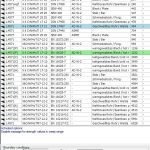Overview of the module package ASME BPVC VIII-1
Due to globalisation, foreign calculation regulations according to DIN EN and ASME are also required. For heat exchangers, the standards according to TEMA (Tubular Exchanger Manufactures Association) and since 2005 according to section UHX of the ASME BPVC Part VIII-1 are often used.
The LV program package enables the user to calculate the strength of pressure vessel components such as cylindrical, spherical and conical shells, heads, plates and flanges according to ASME VIII, Div. 1 and the calculation of the tube sheets of heat exchangers according to UHX or TEMA. An extensive materials database is included.
It contains approx. 4400 materials according to American, European and German standards, which are specified in detail in the calculation modules. In addition, a project sheet is available in which all items to be calculated can be entered. The documentation is carried out with the relevant equations, optionally in German / English. With the LV-Excel-ADD-IN you can transfer values in an Excel table to an LV program or transfer calculation results from the program to the table. This means, for example, that existing Excel calculations can still be used, while at the same time a complete pressure vessel calculation is integrated.
The calculation documentation is similar to the EN standards.
Single modules, which are not listed in this overview, can be found in the alphabetical list of the price list.
Interfaces to CAD systems on request.

Project – BOM
The Project module summarizes operational and test data, as well as the main parts of a pressure vessel including main geometrical data and used material in one working sheet. For the final calculation, the specified modules are adjusted and their data are connected to the working sheet.
The Project module determines which calculation code is used and according to which standard the material definition should be done.
Material Database – WERK
Selection and documentation of materials for the design of pressure vessels
The program determines the permissible strength characteristics depending on temperature, component geometry, the code and delivery standard. All values are displayed, can be printed, copied to the clipboard, stored in a file (e.g. for further processing with MS WORD) or transferred to any calculation modules such as AD 2000/EURONORM/ASME/TRD
The material server is bilingual. You can switch from German to English and vice versa.
 Fully integrated material database
Fully integrated material database

Test pressure according to ASME VIII UG-99 and UG-100
Module UG99 can be used to calculate the maximum allowable test pressure according to ASME VIII-1
UG-99 for a calculation project with several chapters.
After starting, two options can be selected:
- Test pressure and material characteristics according to UG-99/UG-100:
- Maximum allowable working pressure acc. to UG-99/UG-100

UG-27 Thickness of cylindrical and spherical shells under internal pressure
Under internal overpressure, cylindrical and spherical shells are subjected to tensile stresses. The wall must be sufficiently dimensioned so that this stress does not lead to the failure of a component.
The Ug27 module determines the required wall thickness and the allowable overpressure for the existing wall thickness. For the calculation of sections according to UG37, the required wall thickness at 100 % utilisation is also given.

UG-28 Thickness of shells and tubes under external pressure
Under external overpressure, cylindrical or spherical shells can fail due to plastic or elastic buckling. The ASME code contains material-temperature curves for the various material groups which can be used to determine the permissible external overpressure.
Module UG28 can be used to calculate the allowable external overpressure for cylindrical and spherical shells. The required wall thickness is determined iteratively.

UG-29 Reinforcement rings at cylindrical shells under external overpressure
The calculation of the necessary moments of inertia of the reinforcements for
vessels under external overpressure is carried out for both cases
taking into account
- the moments of inertia of the wall and the reinforcement
- the moment of inertia of the reinforcement alone.
In the module a comparison between the existing and the
required moment of inertia is carried out,
a violation of the strength condition is displayed.
The existing moments of inertia of reinforcement rings can be automatically transferred from the BIEG module.

UG-32 Dished ends under internal overpressure
Spherical, elliptical,
torispherical or conical geometries can be used for heads or reducers. The
deviation from the spherical shape is taken into account
by form factors in the ASME code in the case of internal overpressure. For cones,
the wall thickness at the widest diameter and the cross-section of the
corner connection must also be checked.
The UG32 module determines the required wall thickness of
elliptical, torispherical or hemispherical heads under
internal pressure. In the case of dished heads (Kloepper type and Korbbogen type) the geometry
is specified accordingly by the program.
For cones, the shell and the knuckle as well as the corner connection at the wide and narrow end can be calculated.

UG-33 Dished ends under external overpressure
Spherical, elliptical,
torispherical or conical geometries can be used for heads or reducers. The
deviation from the spherical shape is taken into account in the ASME code
via a geometry factor for evaluation of the
material-temperature curve in the case of external overpressure. For cones,
the cross-section and, in the case of effective reinforcements,
the area moment of inertia of the corner connection must also be checked.
The UG33 module determines the required wall thickness of the heads under
external pressure. In the case of dished heads (Kloepper type and Korbbogen type) the geometry
is specified accordingly by the program. For cones, the cross-section and the effective stiffening of the
corner connection at the wide and
narrow end can also be calculated.

UG-34 Flat ends or plates with flange moment
The different designs of flat ends or plates are
taken into account in the calculation using coefficients. The special types
are illustrated graphically. For bolted plates, the flange moment
must also be taken into account.

UG-37 Openings in shells and heads
The Ug37 module can be used to design inserted or set-on nozzles with
or without a reinforcing disc. For the calculation of
adjacent openings, the values of the single nozzles are to be taken over.
In the case of openings in pressure vessels, the missing pressure-bearing
shell surface must be replaced by surface reserves in the shell and nozzle or by a
reinforcing plate. If the run-out lengths of two adjacent nozzles overlap,
the existing area must still be sufficient
to replace the cut-out area.

Flanges incl. Flange tables (AFLT – ANSI / ASME B16.5)
Flange connections must be leak-proof in installation / operating condition.
The required bolt forces load the flange with a
bending moment. For the different flange types,
the stresses occurring can be determined from measurement curves on the basis
.
The AFL module can be used to calculate inserted integral flanges and loose flanges /
loose flanges with collar or without tapered shoulder. For
the installation condition a design for the max. bolt force
is possible. The required auxiliary variables are displayed.

ANSI
The ANSI standard B36.10 defines the dimensions of
steel pipes. The pipes are designed to withstand static loads caused by
internal pressure in accordance with ASME/ANSI B31.3.
The ANSI module determines the pipe dimensions according to ANSI B36.10 and the
required wall thickness according to ASME/ANSI B31.3. Pipe bends are
taken into account.

APY – flat face flanges with metal-to-metal contact outside the bolt circle according ASME BPVC Appendix Y
Flange Class I, A=16 in. = 406.4
mm, B = 10 in. = 254 mm, C = 14 in. = 355.6 mm, G = 11 in. = 279.4 mm,
g0 = g1 = 0.375 in. = 9.525 mm, allowable stress Szul = 131 MPa,
Internal pressure P = 700 psi = 4.826 MPa
Y1/Y2 = (A-B+g0)/(A-C+g0) = (406.4–254+9.525) / (406.4-355.6+9.525) = 162/ 60.3 = 2.7
Required flange thickness:
acc. to APY: t = 28.58 mm = 1.125 in
acc. to AD-B8: t=45 mm (Y1/Y2 = 2.7)

ATB spherical dished heads according to Appendix 1 – 6
In the case of spherically dished heads, the greatest stress lies in the transition area
to the spherical dome and in the flange. Appendix 1-6 to the ASME Code
sets out calculation equations for the various
forms of design
The ATB module determines the required wall thickness of spherical dished heads
and the required flange thickness for internal and full face gaskets. With
dished heads without additional flange rings, clamp bolts are also
considered.

TEB2 Calculation of pipe bends and T-pieces according to ANSI / ASME B31.3
The module calculates the stress profile of a pipe bend or a T-piece according to ASME.
The material database is used to
compare the calculated stresses with the allowable stresses of the
selected material.

Design of tube sheets according to ASME BPVC UHX
The module package UHX is divided into three modules for U-tube,
fixed and floating tubesheet heat exchangers acc. section UHX of the ASME BPVC
Part VIII-1. The package comprises:
- UHXa module: U-tubesheets acc. UHX-12
- UHXb module: Fixed tubesheets acc. UHX-13
- UHXc module: Floating tubesheets acc. UHX-14
- The required calculation cases 1-7 for shell or tube side pressure and thermal expansion.
- Input of the configuration (a-f) for fixed tubesheets and (A-D) for floating tubesheets.
- Calculation of the operation and test cases
- Detailed help file in Adobe PDF format including all examples acc. ASME-UHX-20
Module package ASME VIII Div. 1 incl. Material Database
The calculations can also be performed according to the corresponding EURONORM.
see also:
Dieser Beitrag ist auch verfügbar auf:
 Deutsch (German)
Deutsch (German)